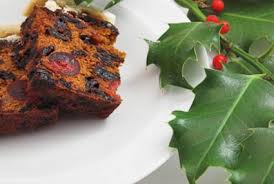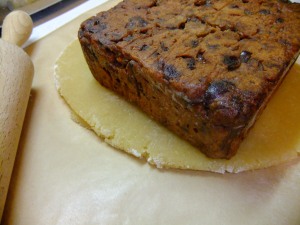
Gluten-free Christmas cake
We love this cake which I adapted from the recipe by Rose Cousins, swapping in cooking oils that are better for you. It’s naturally free from gluten and dairy. I made this once, years ago, and it was so delicious we stopped making the “normal” family Christmas cake. Because of the dried fruit, this cake, like all fruit cakes is high in (natural) sugars so it’s never going to be a vitality boosting food. But sometimes, who cares!! These amounts make a 15cm (6”) square cake. If you like a larger cake, use a 18×18 cm square (7”) tin and twice the quantities of ingredients below. You will need to increase the cooking time by around 30 minutes. If you go through the whole process of the greasproof and brown paper your cake will not burn.
Don’t forget to check my larder & shopping section for any new/unusual ingredients
165g stoneless dates (not medjool)
115ml virgin avocado oil, macadamia oil or light olive oil
55g rice flour
55g coconut flour
55g tapioca flour
165g organic un-sulphured sultanas
165g organic un-sulphured raisins
55g organic un-sulphured currants
55g natural glace cherries (without red food colouring), rinsed in hot water to remove sugar syrup, dried, and halved
OR 40g dried sour cherries soaked overnight in boiling water to help them plump up
28g ground almonds
1 heaped tsp mixed spice
3 large eggs (or use Orgran No Egg Egg Replacer from health shops for an egg-free cake – whisk the egg replacer with water before adding to the other ingredients)
Optional: grated rind of 1 unwaxed lemon and orange, organic if possible
Brown paper and oil for greasing
Silicon or grease proof baking paper
A 15cm (6″) square baking tin (or 17.5cm/7″ round tin)
For the almond paste (marzipan) topping (this is not egg-free!):
1 quantity of almond paste from my recipe (posted separately)
1 egg white, lightly beaten
Gluten-free* icing sugar or finely ground xylitol or erythritol Ie.g. NKD Living brand) for rolling
*most icing sugar is GF but do check labels if you need to avoid gluten
1. Line the base and sides of tin with brown paper and greaseproof paper, allowing the brown paper to come at least 2” above top of tin.
2. Wrap an outer collar of brown paper around the tin to come up as high above the tin as the tin itself. Secure with pins or paperclips. This outer collar and all the layers inside stops your cake burning at the edges before it’s cooked at the centre.
3. Chop dates small and place in a pan with 145ml water
4. Simmer on a low heat for 10 mins until the dates are soft. Cool.
5. Preheat oven to 170C
6. Process/beat together dates, oil, almonds, spices, eggs, flours until well blended.
7. Stir in the fruit, mix well by hand. Don’t beat or you will get a cake like concrete.
8. Place in the lined, greased 6” baking tin
9. Bake for 30 mins at 170C
10. Then lower the oven to 145C for another 45 mins. Test with a needle – if it comes out clean, the cake is 100% done.
11. Allow to cool in the tin, then remove and store, still wrapped in paper, until ready to use (or cover in marzipan). I am posting my marzipan recipe separately and will be uploading pictures soon…
To cover the cake with marzipan (almond paste)
- When you are ready to cover the cake with almond paste, remove the paper from the cake. Put a sheet of greaseproof/silicon paper on the work surface and dust with some gluten-free icing sugar or finely ground xylitol.
- Roll out about half the almond paste on the paper: it should be a little less than 1cm thick. Brush the top and sides of the cake with lightly beaten egg white and put the cake, sticky side down, on top of the rolled out almond paste.
- Give the cake a thump to make sure it sticks and then cut around the edge. If the cake is a little “round shouldered”, cut the almond paste a little larger.
- With a palette knife press the extra almond paste in against the top of the cake to fill any gaps.
- Measure the circumference of the cake with a piece of string. Roll out 2 long strips of almond paste to half that length: trim both edges to the height of the cake with a palette knife.
- Brush both the cake and the almond paste lightly with egg white. Press the strip against the sides of the cake: do not overlap or there will be a bulge. Use a straight-sided glass to even the edges and smooth the join.
- Rub the cake well with your hand to ensure a nice flat surface. Keep any leftover almond paste keep for later to make chocolate-dipped marzipan balls with (to be posted in the next few weeks!).
- Let the marzipan dry out for at least 2 days before icing the cake as normal (we don’t even eat the icing, we just break it off and eat the rest, but it looks great!)
Why this cake is better for you:
Macadamia nut oil is used for this delicious cake as it can be cooked at temperatures up to 200C without producing harmful trans fats. Trans fats are contained in all polyunsaturated supermarket oils and in any polyunsaturated oils that have been heated. Damaged (trans) fats damage and age your body. So if you want to have great skin, a healthy heart, and tip top digestion, it’s a good idea to phase them out of your diet. Ready meals, takeaways, most cooking oils, and shop-bought biscuits and confectionery are sources of trans fats. The 2 oils that are best for cooking are virgin coconut oil and virgin macadamia oil. Most other oils should be eaten cold-pressed and raw. Extra virgin oil can be added to stews and soups, or to finished dishes, provided you don’t fry with it. If you want to know more about oils that help your health, read “Fats that heal Fats that kill” by Udo Erasmus (more details on www.annacollins.ie). Unsulphured dried fruit does not use sulphur dioxide, a preservative. Sulphur dioxide is acted upon by sulphur-reducing bacteria in your bowel (if your bowel bacteria is imbalanced) and this can cause bloating, gas or headaches if you are suseptable.
Making marzipan with xylitol instead of almond paste makes it kind to your teeth. Xylitol inhibits the bacteria that cause tooth decay from sticking to your teeth. Xylitol is also lower GI than sugar, so is kinder to your body.

